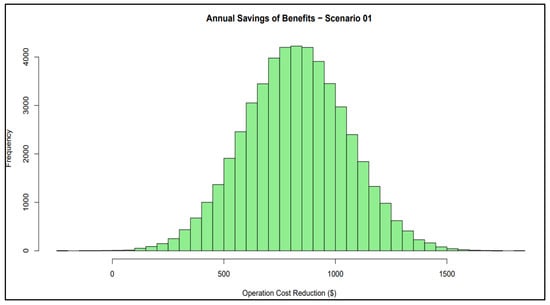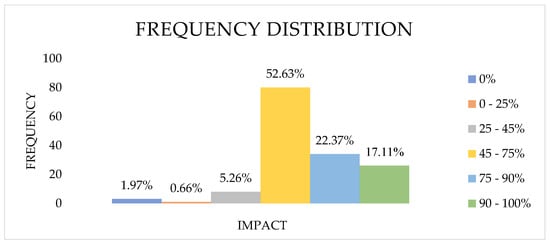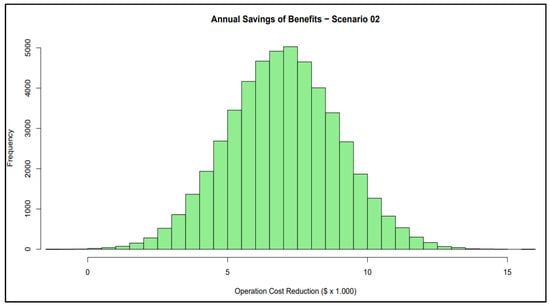Abstract
Smart water consumption metering can provide data at a much more specific spatial and temporal resolution. In this context, smart meters provide essential information for developing customer consumption models, which can be used to modify behavior, favor water savings, and bring other benefits. Therefore, this study aims to evaluate the benefits of the smart metering system implemented in the pilot project for the individualization of water consumption in a residential block in the city of Brasília/DF, Brazil. To assess the benefits, two scenarios were considered: the first contemplated only the implementation of the system, whereas the second contemplated the possible impact of establishing a detailed temporary water balancing system and a leak alarm system for the consumer units. The results revealed that the adoption of these two features resulted in a financial return that was 8.5 times higher than average.
1. Introduction
Water distribution models are the subject of numerous scientific works that aim to approximate the values observed with the aid of pressure and flow measurement equipment to those calculated from developed hydraulic models. To increase their reliability, the correct determination of water consumption is a very important factor. The great variability and randomness of the patterns of use of water resources greatly impair the adoption of the correct values for the flow and demand, a fundamental parameter for the accuracy of the results of the proposed models.
In this sense, there are many works dedicated to elucidating the problems of demand determination.
Carpentier and Cohen (1991) [1] presented a technique to estimate the demand and leak detection using the flow values of pipes in a steady state.
The hypothesis of the study by Buchberger and Wu (1995) [2] is that residential water use can be characterized by three variables: intensity, duration, and frequency since these three properties can be modeled as an inhomogeneous process of rectangular pulses.
Kumar et al. (2008) [3] proposed a method of estimating the state parameters for well-instrumented distribution networks. The method was applied to two urban networks, considering the measures of the flow in the pipes, pressure at the nodes, and values of water demand.
Torrent and Pérez (2020) [4] modeled the average daily water consumption from real-time flow data from several measurement districts using potential curves.
In this context, smart water consumption measurement can provide consumption data in a much more specific spatial and temporal resolution, that is, at the individual consumer level and in small time intervals, allowing the use of analysis tools for more accurate characterizations of consumption profiles. The use of smart meters provides essential information for understanding consumer behavior models that can be used to modify behavior-favoring water savings.
In addition to being an important tool to assist in the construction of consumption patterns, measurement with smart meters allows the construction of useful models for leak detection, reducing losses, and improving demand management.
Cominola et al. (2020) [5] considered that the adoption of an intelligent measurement system must go beyond the simple automation of the reading and reporting of consumed volumes. To know in-depth about the water consumption of users and obtain a system capable of carrying out commercial and operational management, it is also necessary to associate some factors with automation, namely information technology, data science, and other analytical skills.
For Sánchez et al. (2020) [6], the emergence of the IoT has allowed the construction of smart buildings and cities, capable of better managing their water, energy, and even urban mobility infrastructures. According to the authors, this new technology will be able to transform the operation of water supply systems.
For King and Gage (2017) [7], the Internet of Things is a turning point when it comes to risk management and claims forecasting.
Similarly, Monks et al. (2019) [8] revealed that advanced measurement infrastructures, which allow the automated measurement of water meters at predetermined intervals (generally hourly or every 4 h), means the increasing availability of large sets of data, which opens the world of big data so that water utilities can use data mining to better understand their business. However, according to Monks et al. (2019), the implementation of automated water consumption measurement by itself does not bring the potential benefits that have been associated with it. In addition to implementation, concessionaires also need to evolve their systems, processes, and resources, offering new services.
Finally, the work by Monks et al. (2020) [9], based on the opinions of experts in the water supply system in the Australian market, proposed probability distributions that can be used to model the financial return of the benefits arising from automated metering.
Thus, the present work focuses on Quadra 12 of the Jardins Mangueiral Housing Sector—SHJM—in the city of Brasília/DF, Brazil, to evaluate the benefits of the smart metering (SM) system implemented in the pilot project for the individualization of water meters. The residential condominium consists of 420 units, for which 424 meters were installed, including 420 for the residences (houses and apartments), 3 to compute the water consumption of the common areas, and 1 to determine the volume of water that supplies the condominium tank.
2. Materials and Methods
To assess the benefits of the SM system deployed, two scenarios were considered. The first considered the current reality, that is, only the automation of readings using the advanced measurement infrastructure. The second scenario, on the other hand, evaluated the possible impact of automating the readings using the advanced measurement infrastructure, establishing a leak alarm system in the consumer units, and establishing a detailed water balance, which may be temporary or permanent District Metered Areas (DMAs).
The method used to evaluate the benefits of implementing the automated metering system in the condominium is presented here in two stages. The first consists of the identification of the possible benefits, whereas the second stage deals with the estimation of the reduction of the operational costs from the data provided by the research of Monks (2020). The two steps are detailed below:
- First step: In this step, all the benefits presented by Monks (2019) were compared with the benefits identified in the specific case of the condominium for each of the proposed scenarios. A table was prepared that contained all the identified benefits that arose only from the automation of the readings using the advanced measurement infrastructure, as well as another table that contained all the identified benefits that resulted from the automation of the readings using the advanced measurement infrastructure, the establishment of a leak alarm system, the installations of the consumer units, and the establishment of a detailed water balance, which may be temporary or permanent DMAs.
- Second step: In this step, having collected the data referring to the research carried out by Monks (2020) in Australia together with specialists in water supply, the distribution of frequencies was constructed relative to the impact percentage estimated by the specialists on the operating costs of the benefits identified in scenarios 01 and 02. The distribution represented how much of an impact a benefit, on average, had on reducing operating costs. Then, the operational cost reductions that each of the identified benefits represented were determined. Thus, from the frequency distribution and the operational cost reductions of the benefits, a Monte Carlo Simulation (MCS) was performed (50,000 iterations), whose results were a normal distribution curve of the possible operational cost reduction values. As a reference for the calculations, the percentages (according to the calculated benefits) of the operating costs per connection in 2019, as presented by Caesb in its Financial Statement 2019, were used. This assessment was intended to show the return cost-effectiveness of remote water consumption measurement solutions, considering each of the two scenarios.
3. Results
3.1. Benefits of the Intelligent Measurement System—Scenario 01
In the analysis and given the specificities of the study area, Table 1 reproduced below was developed, where the benefits of the automated measurement for the evaluated case are shown, considering only the automation of readings using the advanced measurement infrastructure:

Table 1.
Identified benefits (scenario 01).
Table 1 contains the observed benefits and results from the qualitative research carried out with specialists from Australia, which was contained in the complementary documentation of the work of Monks et al. (2020), and presents all possible benefits and their economic impact percentages. Table 2 presents the assessment of the impact percentage of each of the benefits identified in the reduction of the operating costs (savings generated), with the number of expert responses by impact intervals (there are six impact percentage intervals: 0%, from 0% to 25%, from 25% to 45%, from 45% to 75%, from 75% to 90%, and from 90% to 100%). In practice, the tables are extracts from the complementary documentation in the work of Monks et al. (2020), with new calculations for the frequencies. The total frequency distribution is also shown in Figure 1, that is, considering all the benefits listed in Table 1 and Table 2.

Table 2.
Impact percentages of benefits (scenario 01).

Figure 1.
Frequency distribution.
To quantify the impact in terms of the reduction in operating costs (USD 259,728,873.33 or USD 371.16/connection in 2019 according to the water utility’s financial statement), it was necessary to estimate the proportional costs of each of the benefits of the operational costs and later carry out the 50,000 iterations of the MCS.
In consultation with the water utility, the proportional costs of the expenses for the reader/billing, the reduction in the estimated invoicing, the costs related to occupational health and safety, and the reduction in the errors/loss of data of residential consumption without revenue were calculated. When it was not possible to estimate the proportional costs, 0% was considered, aiming at simulating the worst possible scenario. To detail the proportional costs of each of the benefits, specific cost estimation work was necessary; the work involved consulting the prices used in the purchase of material and labor hiring and the water utility’s water balance. Table 3 shows the proportional costs considered for each benefit calculated.

Table 3.
The proportion of benefits related to operating costs (scenario 01).
The MCS results are shown in Figure 2 and Table 4. The model that evaluated the operational costs and the proportional impact of the benefits considered a normal distribution for the annual cost reduction, which resulted in a median value of USD 821.24. The probability of achieving a saving of at least USD 440.79 was 95% and a saving of more than USD 1203.42 was 5%.

Figure 2.
Annual savings of benefits (scenario 01).

Table 4.
Summary of MCS results (scenario 01).
3.2. Benefits of the Intelligent Measurement System—Scenario 02
In the analysis and given the specificities of the study area, Table 5 was developed and is reproduced below, where the benefits of automated measurement for the evaluated case are shown, considering the automation of readings using the advanced measurement infrastructure, the establishment of an alarm system for leaks in the consumer units, and the establishment of a detailed water balance, which can be temporary or permanent DMAs.

Table 5.
Identified benefits (scenario 02).
Similar to the previous item, Table 5 contains the benefits found and the qualitative research carried out by the experts in Australia, which was contained in the complementary documentation of the work by Monks et al. (2020) and presents all possible benefits and their economic impact percentages. Table 5, which presents an assessment of the impact percentage of each of the benefits identified in reducing the operating costs (savings generated), with the number of responses of experts by impact intervals (there are six impact percentage intervals: 0%, from 0% to 25%, from 25% to 45%, from 45% to 75%, from 75% to 90%, and from 90% to 100%). The total frequency distribution is also shown in Figure 3, that is, considering all the benefits listed in Table 5 and Table 6.

Figure 3.
Frequency distribution.

Table 6.
Impact percentages of benefits (scenario 02).
As in the previous item, to quantify the impact in terms of reducing operating costs (USD 259,728,873.33 or USD 371.16/connection in 2019 according to Caesb’s financial statement), it was necessary to estimate the proportional costs of each of the benefits related to the operational costs and later carry out the 50,000 iterations of the MCS.
For this purpose, in addition to the costs presented in the previous item (Table 3), the costs related to network leaks, internal leaks (in user facilities), and incidents and indemnity costs/claims (in the latter case, the cost to the user was considered null, benefit I, with all costs absorbed by the sanitation company, benefit F) were calculated. When it was not possible to estimate the proportional costs, 0% was considered, aiming at simulating the worst possible scenario. Table 7 shows the proportional costs considered for each benefit calculated.

Table 7.
The proportion of benefits related to operating costs (scenario 02).
The MCS results are shown in Figure 4 and Table 8. As with the previous scenario, the model considered the operational costs, the proportional impact of the benefits, and a normal distribution for the annual cost reduction, which resulted in a median value of USD 6985.47, with a 95% probability of achieving at least a saving of at least USD 3708.43 and a 5% probability of achieving a saving of more than USD 1,025,284.43.

Figure 4.
Annual savings of benefits (scenario 02).

Table 8.
Summary of MCS results (scenario 02).
4. Discussion
It is important to clarify that the benefits identified in Table 1 and Table 5 refer to those calculated with an impact only on the water utility and to those calculated with an impact only on the users, and it is necessary, therefore, to stipulate the origin of the resources for investors (concessionaire or user) for when they intend to carry out an economic evaluation of this type of project.
However, in the comparison of the two scenarios, it was found that the second scenario presented a financial return that was 8.5 times higher than the first scenario, which makes clear the importance of intelligent measurement going beyond simple automation and reading and the preparation of reports on volumes consumed. It is evident, therefore, that a remote reading project must be able to extract all the benefits that a system can offer, such as the provision of new services to consumers; improvements in demand forecasts and revenue from advanced data analysis, which considers data other than consumption; the establishment of a good capacity for analyzing meter data, measurements, and consumption categories; and increasing knowledge about consumers and network assets, among others.
5. Conclusions and Recommendations
The benefits of smart metering are not restricted to remote reading; there is a positive impact on financial management, the cost of providing the supply service, the cost of using the supply service, and the safety of users. However, it is important to point out that the achievement of all the benefits that remote measurement provides depends on the development of other requirements and tools such as those exemplified in this work.
Based on this work, the need to develop research that evaluates the impact of remote measurement in a regional scenario has been identified, considering the systems already implemented, for the development of new qualitative and quantitative impact assessments.
Author Contributions
Conceptualization, D.C. and A.S.; methodology, D.C.; software, D.C.; validation, A.S.; formal analysis, A.S.; investigation, D.C.; resources, D.C.; data curation, D.C.; writing—original draft preparation, D.C.; writing—review and editing, A.S.; visualization, D.C.; supervision, A.S.; project administration, A.S. All authors have read and agreed to the published version of the manuscript.
Funding
This research received no external funding.
Institutional Review Board Statement
Not applicable.
Informed Consent Statement
Not applicable.
Data Availability Statement
The data presented in this study are available on request from the corresponding author. The data are not publicly available due to the policy on access to information of the water utility.
Conflicts of Interest
The authors declare no conflict of interest.
References
- Carpentier, P.; Cohen, G. State estimation and leak detection in water distribution networks. Civ. Eng. Syst. 1991, 8, 247–257. [Google Scholar] [CrossRef]
- Buchberger, S.G.; Wu, L. Model for instantaneous residential water demands. J. Hydraul. Eng. 1995, 121, 232–246. [Google Scholar] [CrossRef]
- Kumar, S.M.; Narashiman, S.; Bhallamudi, S.M. State estimation in water distribution networks using graph-theoretic reduction strategy. J. Water Resour. Plan. Manag. 2008, 134, 395–403. [Google Scholar] [CrossRef]
- Torrent, S.G.; Pérez, R. Modelling daily water consumption through potential curves. Disaggregating apparent and real losses. Urban Water J. 2020, 17, 292–302. [Google Scholar] [CrossRef]
- Cominola, A.; Monks, I.; Stewart, A. Smart Water Metering and AI for Utility Operations and Customer Engagement: Disruption or Incremental Innovation? HydroLink 2020, 4, 114–119. [Google Scholar]
- Sánchez, A.S.; Oliveira-Esquerre, K.P.; Nogueira, I.B.R.; Jong, P.; Filho, A.A. Water Loss Management through Smart Water Systems. In Smart Village Technology; Patnaik, S., Sen, S., Mahmoud, M.S., Eds.; Springer: Berlin/Heidelberg, Germany, 2020; pp. 233–266. [Google Scholar]
- King, T.; Gage, K. Insurance 2.0 Is a Game Changer. Property Casualty 360. Available online: https://propertycasualty360/2017/04/27/insurance-2-0-is-a-game-changer (accessed on 30 January 2021).
- Monks, I.; Stewart, R.A.; Sahin, O.; Keller, R. Revealing Unreported Benefits of Digital Water Metering: Literature Review and Expert Opinions. Water 2019, 11, 838. [Google Scholar] [CrossRef]
- Monks, I.; Stewart, R.A.; Sahin, O.; Keller, R.; Choy, S.L. Expert Opinion Valuation Method to Quantify Digital Water Metering Benefits. Water 2020, 12, 1436–1457. [Google Scholar] [CrossRef]
Publisher’s Note: MDPI stays neutral with regard to jurisdictional claims in published maps and institutional affiliations. |
© 2022 by the authors. Licensee MDPI, Basel, Switzerland. This article is an open access article distributed under the terms and conditions of the Creative Commons Attribution (CC BY) license (https://creativecommons.org/licenses/by/4.0/).